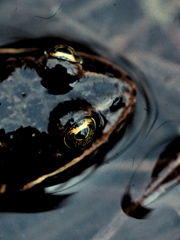|
OREGON SPOTTED FROG } Rana pretiosa

|
RANGE: Small, isolated areas in Oregon, Washington, and British Columbia
STATUS: Declared Imperiled by NatureServe but not protected under the Endangered Species Act
THREATS: Habitat loss due to development; gravel mining; water diversion; livestock grazing; introduction of nonnative species; and water contamination from pesticides, fertilizers, and acid rain
Named for the irregularly shaped, irregularly sized black spots dotting its head, back, sides, and legs, the Oregon spotted frog also has a reddish color on its abdomen that distinguishes it from other native Northwest frogs. Its call, a series of rapid, low clucking noises, is made by males during the breeding season, both underwater and on the water’s surface. Though the species has a historic range that stretches from California up north past the U.S.-Canadian border, encroachments on its wetland habitats and the introduction of nonnative plants and animals have almost totally extinguished the frog. But even after the Center for Biological Diversity petitioned to give the Oregon spotted frog the federal protection it needs, the U.S. Fish and Wildlife Service declined to put it on the endangered species list, declaring the frog a mere “candidate” for protection.
LEARN MORE ABOUT THE OREGON SPOTTED FROG
|